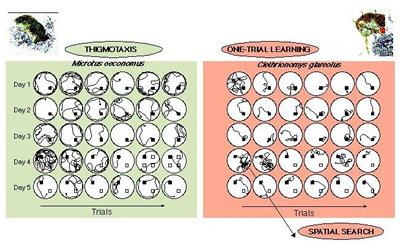
Assessing behavior, memory and learning of genetically modified mice by factor analysis based on track analysis using EthoVision and WinTrack
H.P. Lipp and D.P. Wolfer
Institute of Anatomy, University of Zürich, Zürich, Switzerland
Video tracking and computer-assisted analysis of locomotor paths is a powerful tool in the growing field of phenotypic analysis of genetically modified mice. The technique lends itself to tests requiring large arenas such as the Morris water maze and open field analysis, but is also applicable to other tests based. We have tested water maze learning of 3500 mice from many strains and genetically modified lines, using two standardized procedures. Likewise, nearly 2000 mice have been tested in an open field set-up. Most data have been recorded by using a Noldus EthoVision system. Because of the constantly ongoing refinement of data analysis, we use an off-line analysis program (WinTrack by D.P. Wolfer). By means of a macro language, the stored path data in form of XY-coordinates from every trial are first cleaned from recording artifacts. Behavioral variables are then extracted and tabulated in ASCII code as specified by the experimenter. The tables can be imported into any statistical program. WinTrack also imports track data from other systems. This approach enables us to conduct meta-analyses on large data sets, primarily by ANOVA and factor analysis, which reduces the large number of variables to a smaller set of factors thought to reflect processes underlying activity, learning and memory.
For the Morris maze
(Figure 1), factor analysis revealed the following:
· The range of behavioral variation across "normal" mouse strains is as large
as the variation found across genetically modified mice. This means that environmental
variables and genetic background must be controlled carefully. For genetically
modified mice, we recommend to test littermates from crosses involving two inbred
strains.
· 3-4 independent factors account for most of the behavioral variation. The
predominant factor is wall hugging ("thigmotaxis") which co-varies with many
measures of acquisition such as path length, time in target quadrant, swim path
length and special indices such as the Gallagher index. A second factor is differential
swimming speed, while a third independent factor is linked to differences in
probe trial scores, that is, a trial in which the animals are searching around
the position of a removed target platform. Despite of its frequent citation
as a spatial memory index in the literature, it is rarely influenced specifically
by targeted mutations. Rather, our data imply that most genetically engineered
mutations with behavioral phenotypes in the water maze increase thigmotaxis,
probably by reducing behavioral flexibility.

Figure 1. Representative swimming tracks of two species of mice in the Morris maze.
For the open field, are data are more congruent with the rat literature in revealing 3-4 factors:
In conclusion, the analysis of paths provides remarkable insight into the genetic and functional architecture of memory and learning.
Supported by SNF 31-54184.98; 31-57139.99; BIO4CT980297/BBW98.0125 and EMDO.
Paper presented at Measuring Behavior 2000, 3rd International Conference on Methods and Techniques in Behavioral Research, 15-18 August 2000, Nijmegen, The Netherlands